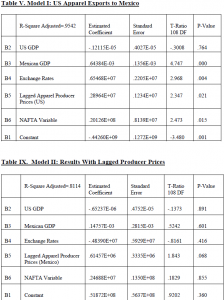John F. Yoder and Dr. Scott Bradford, Economics
Prior to the enactment of the North American Free Trade Agreement, critics predicted NAFTA would harm the US economy. Even proponents of NAFTA admitted that free trade between the US, Canada, and Mexico would shift low-skilled jobs to Mexico where such work could be done more cheaply. Most economists predicted that such a job shift would occur in the apparel industry, which employs low-skilled workers. For example, Alain de Janvrey noted that “intra-industry trade in this case [between NAFTA countries] is importantly motivated by the chase for cheap labor and hence can induce systematic plant relocation toward Mexico” (de Janvrey, 1991, 1). After Congress enacted NAFTA in 1994, tariffs supposedly decreased in low-skilled industries such as apparels. Why then have US apparel exports to Mexico more than doubled since NAFTA went into effect? In addition to the increase in the United States’s apparel exports, apparel imports from Mexico also increased.
In order to analyze changes in the US and Mexico’s apparel industry trade, this project uses two econometric models of US apparel exports to Mexico and Mexican apparel exports to the US. By modeling US exports to Mexico with NAFTA, I show how much of an influence NAFTA had on the US/ Mexican apparel trade. In order to factor out other influences on the US/ Mexican apparel trade such as GDP, producer prices, and exchange rates, the models include these variables as well.
The NAFTA dummy variable is the most important parameter in this project. Unfortunately, the NAFTA dummy picks up any post-1994 effect on US apparel exports to Mexico. Other factors will also show up in this variable. For example, Mexico devalued its currency in 1994. This devaluation enabled the US to more easily buy Mexican apparel exports, and will show up in the NAFTA variable. At the same time, the devaluation made it harder for Mexico to buy US apparel exports. In light of the devaluation of the peso, the US was less likely to experience significant increases in apparel exports to Mexico since 1994. However, as indicated in the body of this paper, apparel exports to Mexico significantly increased after 1994. Without the peso devaluation, the effects of NAFTA would have likely been greater.
The first econometric model indicates that NAFTA has a positive effect on US apparel exports to Mexico. Using the model corrected for auto-correlation and lagged producer prices, US apparel exports to Mexico increased $20,126,000 as a result of NAFTA’s enactment in 1994, holding all the other variables constant. A $20,126,000 per month increase in US apparel exports to Mexico seems small considering that total US apparel exports to Mexico in 1998 exceeded $3 billion. However, the mean of all monthly US apparel exports to Mexico since 1994 equals $152,608,458. The per month NAFTA increase amounts to 13% of the mean of the monthly US apparel exports to Mexico.
Model II’s results corrected for auto-correlation are not significant. As a result, nothing can be concluded about NAFTA’s effects on Mexican apparel exports to the US. However, this non-result could be due to the rules of origin and tariff preference levels incorporated into NAFTA. These protectionary measures set quotas on the amount of certain apparels that can originate in each country. In addition, the old Multi-Fiber Agreement continues to limit the growth of US apparel imports.
References
- De Janvrey, Alain; Sadoulet, Elisabeth.1997. “NAFTA and Agriculture: An Early Assessment,” University of California, Berkeley, Department of Agricultural and Resource Economics, Working Paper: 807, January, p26.

